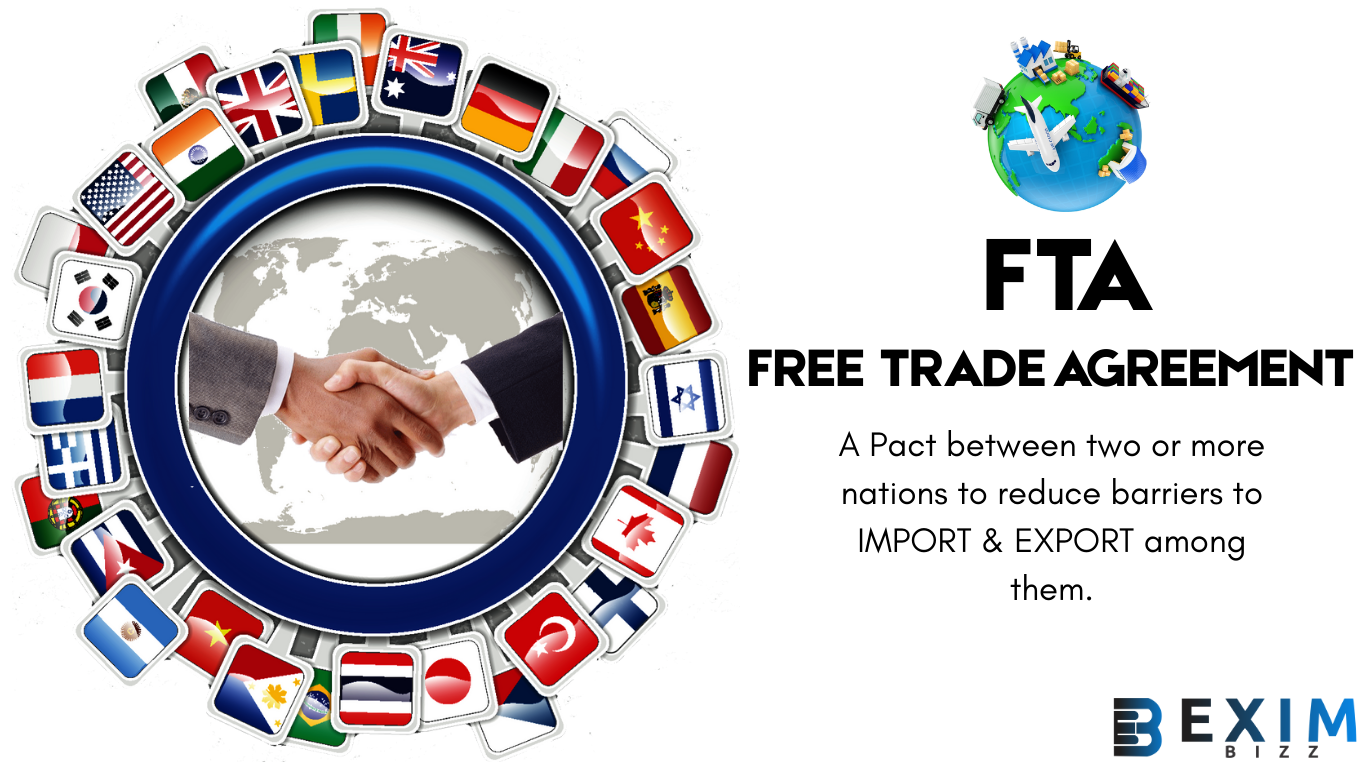In an increasingly interconnected global economy, Free Trade Agreements (FTAs) have become a cornerstone of international trade. India, as one of the fastest-growing economies in the world, has actively engaged in FTAs to strengthen its trade relationships, boost exports, and integrate itself into global supply chains. In this blog, we’ll explore how India’s FTAs work, their benefits for businesses and consumers, and where you can stay updated on new rules and regulations.
What Are Free Trade Agreements (FTAs)?
A Free Trade Agreement (FTA) is a treaty between two or more countries to reduce or eliminate trade barriers such as tariffs, quotas, and restrictions on goods and services. The primary goal of an FTA is to promote economic integration by making it easier and cheaper for businesses to trade across borders.
India has signed several FTAs with countries and regions, including ASEAN (Association of Southeast Asian Nations), Japan, South Korea, and the United Arab Emirates. These agreements aim to enhance market access, foster investment opportunities, and create win-win scenarios for all parties involved.
How Do India’s FTAs Work?
India’s FTAs are designed to streamline trade processes and make them more efficient. Here’s a breakdown of how they function:
- Tariff Reductions and Eliminations:
Under an FTA, participating countries agree to lower or eliminate tariffs on specific goods and services. For example, under the India-ASEAN FTA, many Indian products enjoy duty-free access to ASEAN markets, while ASEAN countries gain similar advantages in India. - Rules of Origin:
To ensure that only goods originating from FTA member countries benefit from reduced tariffs, strict “rules of origin” are established. These rules specify the minimum level of local content required for a product to qualify as originating from a member country. - Trade Facilitation Measures:
FTAs often include provisions to simplify customs procedures, reduce paperwork, and expedite clearance times. This helps a lot with businesses by saving time and costs associated with cross-border trade. - Sector-Specific Provisions:
Some FTAs focus on specific sectors like agriculture, textiles, pharmaceuticals, or IT services. For instance, the India-Japan Comprehensive Economic Partnership Agreement (CEPA) emphasizes collaboration in high-tech industries and infrastructure development. - Dispute Resolution Mechanisms:
FTAs typically include mechanisms for resolving trade disputes between member countries. This ensures that any disagreements over implementation or interpretation of the agreement are addressed fairly.
Benefits of India’s FTAs
India’s participation in FTAs offers numerous advantages for businesses, consumers, and the overall economy:
- Increased Market Access:
By reducing tariffs and other trade barriers, FTAs open up new markets for Indian exporters. For example, the India-UAE Comprehensive Economic Partnership Agreement (CEPA) provides Indian companies with greater access to the UAE’s strategic location as a gateway to Africa and Europe. - Boosting Exports:
FTAs help Indian industries compete globally by offering competitive pricing due to lower tariffs. Sectors like textiles, gems and jewelry, pharmaceuticals, and IT services have significantly benefited from increased exports under these agreements. - Attracting Foreign Investment:
FTAs signal stability and openness to foreign investors. Countries partnering with India through FTAs are more likely to invest in Indian projects, creating jobs and fostering technological advancements. - Consumer Benefits:
Lower tariffs on imported goods mean consumers enjoy access to a wider variety of affordable products. For instance, Indian shoppers now have access to competitively priced electronics and automobiles from FTA partner nations. - Strengthening Diplomatic Ties:
Beyond economics, FTAs deepen diplomatic relations between countries. They foster mutual trust and cooperation, paving the way for broader collaborations in areas like education, healthcare, and climate action. - Supporting SMEs:
Many FTAs include provisions to assist small and medium enterprises (SMEs) in navigating international markets. This empowers smaller players to expand their reach and contribute to India’s export growth.
Challenges and Considerations
While FTAs offer significant benefits, they also come with challenges:
- Competition: Domestic industries may face stiff competition from cheaper imports, requiring them to adapt and innovate.
- Implementation Gaps: Ensuring compliance with complex rules of origin and other regulatory requirements can be challenging for businesses.
- Balancing Interests: Policymakers must strike a balance between protecting sensitive sectors (like agriculture) and promoting liberalized trade.
To maximize the benefits of FTAs, governments and businesses need to invest in capacity-building initiatives, improve infrastructure, and enhance awareness about available opportunities.
Where Can You Stay Updated on New Rules and Regulations?
Staying informed about updates to existing FTAs or new trade agreements is crucial for businesses looking to leverage these opportunities. Here are some reliable sources to keep track of developments:
- Directorate General of Foreign Trade (DGFT):
The DGFT website (https://www.dgft.gov.in/) provides comprehensive information about India’s FTAs, including notifications, guidelines, and export-import policies. - Ministry of Commerce and Industry:
The official portal of the Ministry of Commerce and Industry (https://commerce.gov.in/) regularly publishes updates on ongoing negotiations, signed agreements, and policy changes. - World Trade Organization (WTO):
As a member of the WTO, India adheres to global trade norms. The WTO website (https://www.wto.org/) offers insights into multilateral trade discussions that may impact FTAs. - Embassy Websites:
Embassies of FTA partner countries often share updates on trade-related announcements. For example, the Embassy of Japan in India might provide details about CEPA-related developments. - Industry Associations:
Organizations like the Federation of Indian Export Organisations (FIEO) and Confederation of Indian Industry (CII) frequently organize webinars, workshops, and publications to educate stakeholders about FTAs. - News Outlets and Think Tanks:
Reputable news platforms like The Economic Times , Business Standard, and think tanks such as ICRIER (Indian Council for Research on International Economic Relations) offer analysis and commentary on trade agreements. - Customs Authorities:
The Indian Customs Electronic Gateway (ICEGATE) (https://www.icegate.gov.in/ ) provides real-time updates on customs regulations and tariff schedules linked to FTAs.
Conclusion
Free Trade Agreements play a pivotal role in shaping India’s trade landscape, offering immense potential for economic growth, job creation, and enhanced consumer welfare. However, unlocking their full benefits requires proactive engagement from both the government and private sector. By staying updated on new rules and regulations through credible sources, businesses can position themselves to thrive in an ever-evolving global marketplace.
Whether you’re an exporter exploring untapped markets or a consumer enjoying better choices, India’s FTAs are instrumental in driving progress. So, embrace the opportunities they present and stay ahead of the curve by keeping yourself well-informed!






